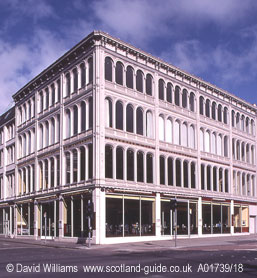The wealth of the Victorian middle class was generally reflected in the large houses built in the West End and in some enclaves in the Southside such as Pollokshields.
In addition, the large disposable income of the well-off led to the development of bustling shopping areas such as Buchanan Street where substantial warehouses (the forerunners of today`s department stores) were established. Consumerism isn`t a recent phenomenon in Glasgow! The best example of this type of shop still exists at 45 Buchanan Street (1883-5) but elsewhere in the city centre there are fine examples of exuberant Victorian architecture which represent the confidence and flamboyance of the city`s main retailers in the late nineteenth century.
The best-known architects of the city`s schools were Hugh and David Barclay, partly
because they built so many schools for the Govan School Board whose area covered
parts of the West End as well as Govan itself. The best-known individual school
of the Victorian period is the very grand Glasgow High School (1846-7,
Charles Wilson) on Elmbank Street. Charles Rennie Mackintosh`s Scotland Street
School (1904-6) was built only sixty years later but it is radically different
from not only Wilson`s building but also the more usual school designs such as
Woodlands Public School.
Other public institutions such as hospitals were sometimes afforded the luxury of fine buildings; both the Royal Infirmary and the Western Infirmary still have vestiges of older buildings but these are now dwarfed by their more modern counterparts.
Just outside the city, the surrounding burghs benefitted greatly from
the city`s manufacturing successes and they erected large public buildings,
such as Govan Town Hall (1879-1901), which were intended as statements
of the wealth and independence of the local people. However, the independence
often didn`t last very long and between 1846 and 1912 many populous outlying
districts were annexed by Glasgow, giving the city a population which
peaked at over 1,100,000 just before the Second World War.
This article is based on the guidebook "The Glasgow Guide".

This is a good example of how the local architects used the city`s expertise in steelwork (as developed in the shipbuilding industry) to explore innovative building techniques.